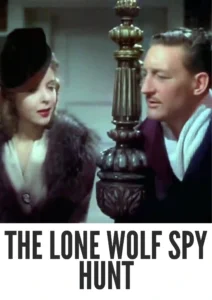Video Sources 0 Views
- The Lone Wolf Spy Hunt 1939 Colorized


Synopsis
Table of Contents
ToggleEspionage, Intrigue, and a Master Thief: ThSpy Hunt (1939) in Vivid Color
Immerse yourself in the thrilling world of international espionage with The Lone Wolf Spy Hunt, a captivating crime mystery from 1939, now beautifully colorized for a modern viewing experience. Starring Warren William as the suave and cunning Michael Lanyard, this film delivers a suspenseful blend of mystery, action, and intrigue. Perfect for fans of classic crime films and those seeking a taste of pre-war espionage thrillers, this HD download brings a thrilling piece of cinematic history to your screen.
The Lone Wolf Spy Hunt Storyline: A Web of Deceit and Danger
The Lone Wolf Spy Hunt follows the adventures of Michael Lanyard, also known as the Lone Wolf, a reformed jewel thief who finds himself embroiled in a dangerous game of international espionage. When a valuable formula is stolen, Lanyard is drawn into a web of deceit and danger as he attempts to recover the missing formula and expose the spies responsible.As Lanyard investigates, he encounters a cast of intriguing characters, including a beautiful and mysterious woman who may or may not be trustworthy. A series of thrilling chases, clever disguises, and close calls ensues as Lanyard races against time to prevent the formula from falling into the wrong hands. Ultimately, The Lone Wolf Spy Hunt is a fast-paced and entertaining thriller that offers a glimpse into the world of pre-war espionage.
Movie Cast
The film features a talented cast of actors who bring this suspenseful story to life:
- Warren William as Michael Lanyard, the Lone Wolf
- Ida Lupino as Valérie
- Rita Hayworth as Karen
- Stephen Geray as Anton Von Remer also known as Stephen Geray
Movie Genre
The Lone Wolf Spy Hunt falls into the genre of crime mystery, with elements of action and suspense that are characteristic of the Lone Wolf film series. Its intricate plot and atmospheric setting make it a captivating and engaging film.
Historical Context: Pre-War Intrigue and The Lone Wolf Series
Released in 1939, The Lone Wolf Spy Hunt represents a thrilling installment in the popular Lone Wolf series of films, showcasing the adventures of the charismatic reformed thief Michael Lanyard. The film was produced during a period of growing international tension, as the world teetered on the brink of World War II. The Lone Wolf Spy Hunt reflects the anxieties and concerns of the time, offering a glimpse into the world of espionage and intrigue that dominated the headlines.
Colorization Details
This colorized version of The Lone Wolf Spy Hunt has been meticulously restored using modern digital techniques, enhancing the visual appeal while preserving the film’s original atmosphere of suspense and excitement. The colorization process involved carefully analyzing the grayscale tones of the original black and white footage and assigning appropriate colors to each scene. This painstaking process brings new life to the characters and settings, making the story even more engaging for modern audiences. While some may debate the merits of colorizing classic films, it introduces these films to a broader audience, ensuring their legacy for future generations.
Technical Details
- Director: Joseph H. Lewis
- Screenplay: Jonathan Latimer
- Story by: Louis Joseph Vance
- Cinematography: Lucien Ballard
- Edited by: Gene Havlick
- Production Company: Columbia Pictures
- Distributed by: Columbia Pictures
- Runtime: 67 minutes
Technical Specifications
- Download Format: MP4
- Resolution: HD (1080p)
- Compatibility: Compatible with most devices, including smartphones, tablets, computers, and smart TVs.
Reviews and Critical Reception
The Lone Wolf Spy Hunt (1939) is a thrilling entry in the Lone Wolf series, offering a suspenseful blend of mystery, action, and intrigue. With its charismatic lead performance by Warren William and its timely themes of espionage and international intrigue, the film remains a captivating and entertaining example of pre-war cinema. As a classic crime film with a touch of spy thriller, The Lone Wolf Spy Hunt provides a unique perspective on the anxieties and concerns of a world on the brink of war.
FAQs
- Q: What is The Lone Wolf Spy Hunt about?
- A: The Lone Wolf Spy Hunt is a crime mystery about a reformed jewel thief who becomes embroiled in a dangerous game of international espionage.
- Q: Is The Lone Wolf Spy Hunt (1939) part of a film series?
- A: Yes, The Lone Wolf Spy Hunt is part of the popular Lone Wolf series of films.
- Q: Is this version of The Lone Wolf Spy Hunt colorized?
- A: Yes, this version has been professionally colorized to enhance the viewing experience.
- Q: What makes The Lone Wolf Spy Hunt interesting for classic film fans?
- A: The Lone Wolf Spy Hunt offers a glimpse into the world of pre-war espionage and features a charismatic lead performance by Warren William.
- Q: What is the download format?
- A: The download format is MP4, which is compatible with most devices.
- Q: What resolution is the download?
- A: The resolution is HD (1080p), providing a high-quality viewing experience.
Download Now in HD!
Watch The Lone Wolf Spy Hunt Today!











